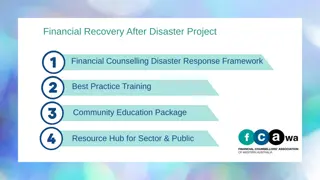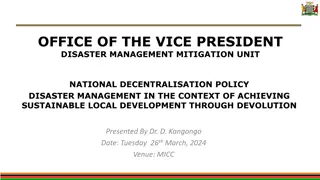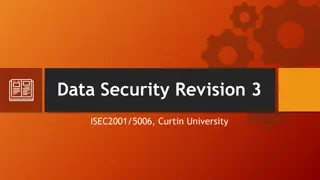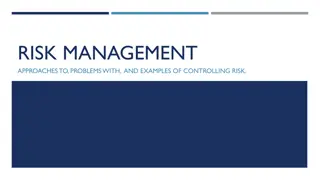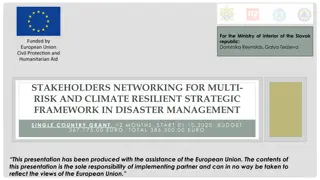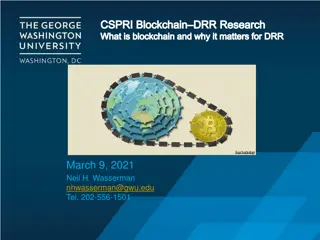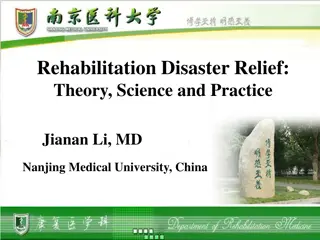Effective Risk Communication Strategies in Times of Disaster
Risk communication plays a crucial role in conveying possible risky situations like natural disasters. Challenges include providing accurate information concisely, addressing cultural and language barriers, and avoiding causing alarm. Barriers to communication involve differences in perception, lack of access to information, and challenges in conveying risk messages through mass media. Effective communication steps include collecting data, understanding the scientific basis of risks, and considering public perception and reactions.
Download Presentation

Please find below an Image/Link to download the presentation.
The content on the website is provided AS IS for your information and personal use only. It may not be sold, licensed, or shared on other websites without obtaining consent from the author.If you encounter any issues during the download, it is possible that the publisher has removed the file from their server.
You are allowed to download the files provided on this website for personal or commercial use, subject to the condition that they are used lawfully. All files are the property of their respective owners.
The content on the website is provided AS IS for your information and personal use only. It may not be sold, licensed, or shared on other websites without obtaining consent from the author.
E N D
Presentation Transcript
RISK COMMUNICATION Facilitating effective messaging in times of disaster.
Risk Communication Messages that convey a possible risky situation, such as upcoming natural disasters Challenges: Providing accurate information concisely and directly Not alarming individuals and/or causing uproar Cultural, education, and language barriers
BARRIERS TO COMMUNICATION
Barriers, part 1 Differences in perception Risk messages will be interpreted in various ways Differences in receptivity People may believe a risk will not affect them in any way Lack of coordination between government and public Governments make risk-related decisions based on experts opinions, but people in high-risk areas tend to have a better understanding of the risk (Janmaimool and Watanabe, 2014)
Barriers, part 2 Access to information Private companies or governments may choose to withhold information from each other or the public, making it difficult to conduct research and reach informed conclusions Population doesn t have a strong scientific background Messages may contain technical terms that are confusing Messages often don t explain if/how these risks will affect people (Food and Agriculture Organization of the United Nations, 1998)
Barriers, part 3 Mass Media Reporters may not accurately convey risk messages accurately due to lack of expertise in the hazard or the risk Media outlets may choose what information is necessary Societal Characteristics Cultural factors (language differences, religious beliefs/laws, etc.) must be considered when crafting effective messages (Food and Agriculture Organization of the United Nations, 1998)
10 STEPS FOR EFFECTIVE COMMUNICATION
Effective Communication, part 1 1. Collect data regarding the risk 2. Understand the scientific basis of the risk 3. Understand the negative impacts that may occur 4. Understand public perception of the risk Surveys, interviews, and focus groups reveal perception 5. Expect varying reactions to the message (Food and Agriculture Organization of the United Nations, 1998) (Fischhoff, 1995)
Effective Communication, part 2 6. Risk comparisons If similar risks have been faced before, risk comparison can be effective Do not compare a new, unfamiliar risk to a previous risk faced 7. Understand the importance of emotional factors Using logic alone is not effective, an emotional appeal can be convincing (Food and Agriculture Organization of the United Nations, 1998) (Fischhoff, 1995)
Effective Communication, part 3 8. Treat the public as a partner Describe the risk and impacts calmly, honestly, and in an understandable way 9. Do not deny concerns Others concerns are legitimate and should be heard to facilitate better decision-making 10.Collaborate with other trusted sources (Food and Agriculture Organization of the United Nations, 1998)
Effective Risk Communication: Spreads accurate information, informing people of potential danger Emphasizes concerns of risk Encourages proper risk mitigation Improves general safety





